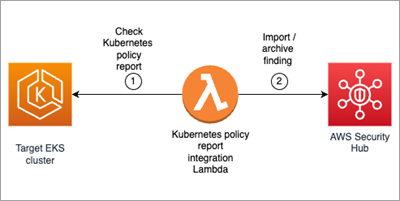Using Kubernetes policy-as-code (PaC) solutions, administrators and security professionals can enforce organization policies to Kubernetes resources. There are several publicly available PAC solutions that are available for Kubernetes, such as Gatekeeper, Polaris, and Kyverno.
PaC solutions usually implement two features:
Use Kubernetes admission controllers to validate or modify objects before they’re created to help enforce configuration best practices for your clusters.
Provide a way for you to scan your resources created before policies were deployed or against new policies being evaluated.
This post presents a solution to send policy violations from PaC solutions using Kubernetes policy report format (for example, using Kyverno) or from Gatekeeper’s constraints status directly to AWS Security Hub. With this solution, you can visualize Kubernetes security misconfigurations across your Amazon Elastic Kubernetes Service (Amazon EKS) clusters and your organizations in AWS Organizations. This can also help you implement standard security use cases—such as unified security reporting, escalation through a ticketing system, or automated remediation—on top of Security Hub to help improve your overall Kubernetes security posture and reduce manual efforts.
Solution overview
The solution uses the approach described in A Container-Free Way to Configure Kubernetes Using AWS Lambda to deploy an AWS Lambda function that periodically synchronizes the security status of a Kubernetes cluster from a Kubernetes or Gatekeeper policy report with Security Hub. Figure 1 shows the architecture diagram for the solution.
Figure 1: Diagram of solution
This solution works using the following resources and configurations:
A scheduled event which invokes a Lambda function on a 10-minute interval.
The Lambda function iterates through each running EKS cluster that you want to integrate and authenticate by using a Kubernetes Python client and an AWS Identity and Access Management (IAM) role of the Lambda function.
For each running cluster, the Lambda function retrieves the selected Kubernetes policy reports (or the Gatekeeper constraint status, depending on the policy selected) and sends active violations, if present, to Security Hub. With Gatekeeper, if more violations exist than those reported in the constraint, an additional INFORMATIONAL finding is generated in Security Hub to let security teams know of the missing findings. Optional: EKS cluster administrators can raise the limit of reported policy violations by using the –constraint-violations-limit flag in their Gatekeeper audit operation.
For each running cluster, the Lambda function archives archive previously raised and resolved findings in Security Hub.
You can download the solution from this GitHub repository.
Walkthrough
In the walkthrough, I show you how to deploy a Kubernetes policy-as-code solution and forward the findings to Security Hub. We’ll configure Kyverno and a Kubernetes demo environment with findings in an existing EKS cluster to Security Hub.
The code provided includes an example constraint and noncompliant resource to test against.
Prerequisites
An EKS cluster is required to set up this solution within your AWS environments. The cluster should be configured with either aws-auth ConfigMap or access entries. Optional: You can use eksctl to create a cluster.
The following resources need to be installed on your computer:
Git command line interface.
Bash shell. On Windows 10, you can install the Windows Subsystem for Linux
AWS Command Line Interface (AWS CLI)
eksctl and Kubectl
Python3 and pip
Step 1: Set up the environment
The first step is to install Kyverno on an existing Kubernetes cluster. Then deploy examples of a Kyverno policy and noncompliant resources.
Deploy Kyverno example and policy
Deploy Kyverno in your Kubernetes cluster according to its installation manual using the Kubernetes CLI.
kubectl create -f https://github.com/kyverno/kyverno/releases/download/v1.10.0/install.yaml
Set up a policy that requires namespaces to use the label thisshouldntexist.
kubectl create -f –



